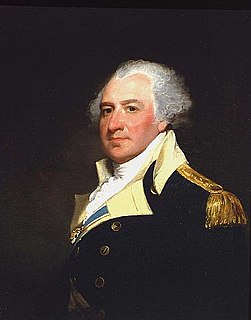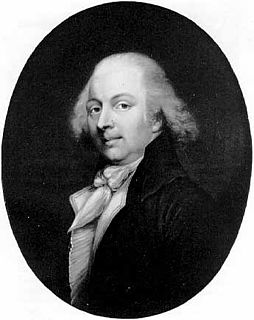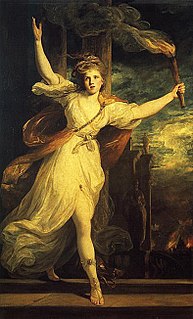
Sir Joshua Reynolds was an English painter, specialising in portraits. John Russell said he was one of the major European painters of the 18th century. He promoted the "Grand Style" in painting which depended on idealization of the imperfect. He was a founder and first president of the Royal Academy of Arts, and was knighted by George III in 1769.

Thomas Gainsborough was an English portrait and landscape painter, draughtsman, and printmaker. Along with his rival Sir Joshua Reynolds, he is considered one of the most important British artists of the second half of the 18th century. He painted quickly, and the works of his maturity are characterised by a light palette and easy strokes. Despite being a prolific portrait painter, Gainsborough gained greater satisfaction from his landscapes. He is credited as the originator of the 18th-century British landscape school. Gainsborough was a founding member of the Royal Academy.

Thomas Mifflin was an American merchant, soldier, and politician from Philadelphia, Pennsylvania. He served in a variety of roles during and after the American Revolution, several of which qualify him to be counted among the Founding Fathers. He was the first governor of Pennsylvania, serving from 1790 to 1799; he was also the last president of Pennsylvania, succeeding Benjamin Franklin and serving from 1788 to 1790.

Field Marshal Jeffery Amherst, 1st Baron Amherst, was a British Army officer and Commander-in-Chief of the Forces in the British Army. Amherst is credited as the architect of Britain's successful campaign to conquer the territory of New France during the Seven Years' War. Under his command, British forces captured the cities of Louisbourg, Quebec City and Montreal, as well as several major fortresses. He was also the first British Governor General in the territories that eventually became Canada. Numerous places and streets are named for him, in both Canada and the United States.

John Hoppner was an English portrait painter, much influenced by Reynolds, who achieved fame as a brilliant colourist.

Admiral of the Fleet Richard Howe, 1st Earl Howe, was a British naval officer. After serving throughout the War of the Austrian Succession, he gained a reputation for his role in amphibious operations against the French coast as part of Britain's policy of naval descents during the Seven Years' War. He also took part, as a naval captain, in the decisive British naval victory at the Battle of Quiberon Bay in November 1759.

Prince Henry, Duke of Cumberland and Strathearn was the sixth child and fourth son of Frederick, Prince of Wales, and Princess Augusta of Saxe-Gotha, and a younger brother of George III. His 1771 marriage to a commoner against the King's wishes prompted the Royal Marriages Act of 1772.
William Pierce or William Pierce, Jr. was an army officer during the American Revolutionary War and a member of the United States Constitutional Convention of 1787.

George Augustus Eliott, 1st Baron Heathfield, was a British Army officer who served in three major wars during the eighteenth century. He rose to distinction during the Seven Years' War when he fought in Germany and participated in the British attacks on Belle Île (France) and Cuba. Eliott is most notable for his command of the Gibraltar garrison during the Great Siege of Gibraltar, which lasted from 1779 and 1783, during the American War of Independence. He was celebrated for his successful defence of the fortress and decisive defeat of Spanish and French attackers.

John Raphael Smith was a British painter and mezzotinter. He was the son of Thomas Smith of Derby, the landscape painter, and father of John Rubens Smith, a painter who emigrated to the United States.
Events from the year 1782 in art.

Giuseppe Ceracchi was an Italian sculptor, active in a Neoclassic style in Italy, England and the nascent United States, who was a passionate republican during the American and French revolutions. He is remembered for his portrait busts of prominent British and American individuals.

John Webber was an English artist who accompanied Captain Cook on his third Pacific expedition. He is best known for his images of Australasia, Hawaii and Alaska.

John Talbot, 1st Earl Talbot, known as John Talbot until 1782 and as The Lord Talbot between 1782 and 1784, was a British peer and politician.
The British Royal Navy purchased HMS Shark on the stocks in 1775. She was launched in 1776, and in 1778 converted to a fireship and renamed HMS Salamander. The Navy sold her in 1783. She then became the mercantile Salamander. In the 1780s she was in the northern whale fishery. In 1791 she transported convicts to Australia. She then became a whaling ship in the southern whale fishery for a number of years, before becoming a general transport and then a slave ship. In 1804 the French captured her, but the Royal Navy recaptured her. Although she is last listed in 1811, she does not appear in Lloyd's List (LL) ship arrival and departure (SAD) data after 1804.

HMS Surprise was a 28-gun Enterprise-class sixth-rate frigate of the Royal Navy, which served throughout the American Revolutionary War and was broken up in 1783.

Admiral Sir Robert Harland, 1st Baronet was a Royal Navy officer. He commanded HMS Tilbury at the Second Battle of Cape Finisterre in October 1747 during the War of the Austrian Succession and commanded HMS Princess Louisa at the Battle of Lagos in August 1759 during the Seven Years' War. He went on to be Commander-in-Chief of the East Indies Station and then First Naval Lord.

HMS Blonde was a 32-gun fifth-rate warship of the British Royal Navy captured from the French in 1760. The ship wrecked on Blonde Rock with American prisoners on board. An American privateer captain, Daniel Adams, rescued the American prisoners and let the British go free. The captain's decision created an international stir. Upon returning to Boston, the American privateer was banished for letting go the British crew and he and his family became Loyalist refugees in Nova Scotia.

Emily Warren, also known as Emily Bertie, Emily Coventry and Emily Pott, (died 1781 or 1782} was a celebrated courtesan in 18th century London who was painted by Sir Joshua Reynolds, George Romney, Nathaniel Dance, and the Scottish miniaturist Charles Shirreff, although the images of Warren by Dance and Shirreff are lost or unidentified. Warren figured prominently in the memoirs of William Hickey.
















